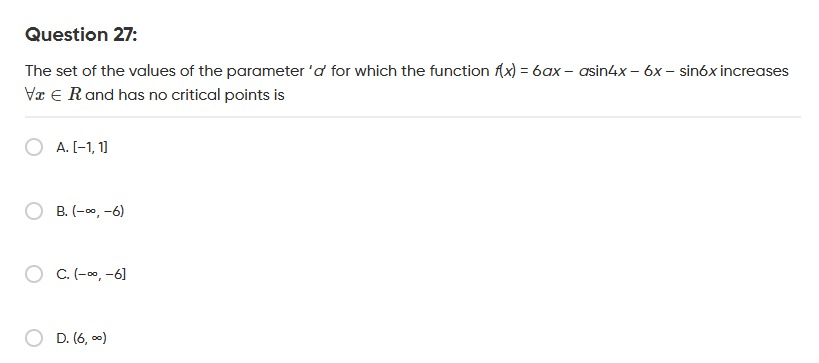Question
Question: The set of the values of the parameter 'a' for which the function $f(x) = 6ax - a\sin4x - 6x - \sin6...
The set of the values of the parameter 'a' for which the function f(x)=6ax−asin4x−6x−sin6x increases ∀x∈R and has no critical points is

[-1, 1]
(-\infty, -6)
(-\infty, -6]
(6, \infty)
(6, \infty)
Solution
For the function f(x) to increase ∀x∈R and have no critical points, its derivative f′(x) must be strictly positive for all x∈R, i.e., f′(x)>0.
The derivative of f(x) is: f′(x)=dxd(6ax−asin4x−6x−sin6x) f′(x)=6a−4acos4x−6−6cos6x f′(x)=(6a−6)−4acos4x−6cos6x
We require f′(x)>0, so: (6a−6)−4acos4x−6cos6x>0 6a−6>4acos4x+6cos6x
This inequality must hold for all x∈R. Thus, 6a−6 must be greater than the maximum value of the expression 4acos4x+6cos6x.
Let M=maxx∈R(4acos4x+6cos6x). The condition becomes 6a−6>M.
Case 1: a>0. To maximize 4acos4x+6cos6x, we can choose x such that cos4x=1 and cos6x=1. This is possible when x is a multiple of π. For example, at x=π, cos(4π)=1 and cos(6π)=1. So, M=4a(1)+6(1)=4a+6. The condition 6a−6>M becomes: 6a−6>4a+6 2a>12 a>6.
Case 2: a<0. Let a=−b where b>0. The expression becomes −4bcos4x+6cos6x. To find the minimum value, we consider the extreme values of cos4x and cos6x. The minimum value of −4bcos4x is −4b(−1)=4b. The minimum value of 6cos6x is 6(−1)=−6. However, these minimums may not occur at the same x. Let's consider f′(x)=(6a−6)−(4acos4x+6cos6x). If a<0, then 6a−6<−6. The term 4acos4x is negative or zero. The term 6cos6x ranges from -6 to 6. Consider x=π. f′(π)=(6a−6)−4a(1)−6(1)=6a−6−4a−6=2a−12. Since a<0, 2a<0, so 2a−12<−12. This means f′(π)<0. Thus, for a<0, the function is not strictly increasing.
Case 3: a=0. f′(x)=−6−6cos6x. The maximum value of f′(x) is −6−6(−1)=0. So f′(x)≤0, and the function is not strictly increasing.
Therefore, the only values of a for which f′(x)>0 for all x is a>6. The set of values is (6,∞).
